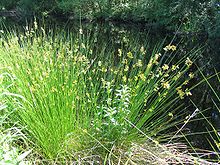Juncaceae
| Rush family | |
|---|---|
 |
|
| Juncus effusus | |
| Scientific classification | |
| Kingdom: | Plantae |
| (unranked): | Angiosperms |
| (unranked): | Monocots |
| (unranked): | Commelinids |
| Order: | Poales |
| Family: |
Juncaceae Juss. |
| Type genus | |
|
Juncus L. |
|
| Genera | |
| Synonyms | |
|
|
Juncaceae is a family of flowering plants, commonly known as rush family. It consists of eight genera and about 464 known species of slow-growing, rhizomatous, herbaceous monocotyledonous plants that may superficially resemble grasses and sedges. They often grow on infertile soils in a wide range of moisture conditions. The best-known and largest genus is Juncus. Most of the Juncus species grow exclusively in wetland habitats. A few rushes are annuals, but most are perennials.
The leaves are evergreen and well-developed in a basal aggregation on an erect stem. They are alternate and tristichous (i.e., with three rows of leaves up the stem, each row of leaves arising one-third of the way around the stem from the previous leaf). Only in the genus Distichia are the leaves distichous. The rushes of the genus Juncus have flat, hairless leaves or cylindrical leaves. The leaves of the wood-rushes of the genus Luzula are always flat and bear long white hairs.
The plants are hermaphroditic or, rarely, dioecious. The small flowers are arranged in inflorescences of loose cymes, but also in rather dense heads or corymbs at the top of the stem or at its side. This family typically has reduced perianth segments called tepals. These are usually arranged in two whorls, each containing three thin, papery tepals. They are not bright or flashy in appearance, and their color can vary from greenish to whitish, brown, purple, black, or hyaline. The three stigmas are in the center of the flowers. As is characteristic of monocots, all of the flower parts appear in multiples of three.
...
Wikipedia
